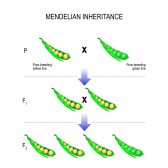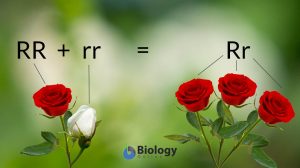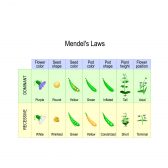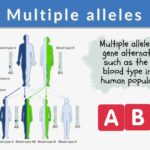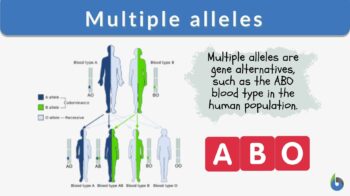
Multiple alleles
n., singular: Multiple allele
[ˈmʌltɪpl̩ ˈæ.liː.l]
Definition: Series of three or more alleles for a gene
Table of Contents
Alleles are the pairs of genes occupying a specific spot called locus on a chromosome. Typically, there are only two alleles for a gene in a diploid organism. When there is a gene existing in more than two allelic forms, this condition is referred to as multiple allelism. Allelism refers to any of the several forms of a gene. These genetic variations arise usually through mutation and therefore are responsible for hereditary variations.
Multiple Alleles Definition
Gregor Mendel suggested that each gene would have only two alleles. Alleles are described as a variant of a gene that exists in two or more forms. Each gene is inherited in two alleles, i.e., one from each parent. Thus, this means there would also be having two different alleles for a trait.
Offspring who have different alleles of a gene are described as heterozygous whereas those that have genotypes made of the same alleles (i.e. of a gene for a particular trait) are described as homozygous.
Although humans (and all diploid organisms) can have only two alleles for any given gene in genetics, multiple allele traits may exist at the population level. Thus, multiple alleles are important in promoting variation within the same species.
In Mendelian inheritance, a given chromosomal locus was occupied by two distinct types of gene alternatives – one dominant and one recessive. These alternatives are two alleles of the same gene. However, in the given population, there are instances wherein there are more than two alternatives (alleles) existing. Those instances are referred to as “multiple allelism” where different forms of the same gene exist within the population. These three or more variants for the same gene are called multiple alleles.
What are multiple alleles? In biology, multiple alleles are three or more alleles for a particular gene. Multiple allelism (biology definition): The condition of the presence of multiple alleles. An example of multiple alleles is the ABO blood group system in humans.
Human gene I (I for ‘isohaemagglutinin‘) exists in three allelic forms: IA, IB, and IO. IA and IB produce type A and type B antigens, respectively, on the cell surface of RBCs whereas IO (or i) is a recessive allele and does not produce antigen. So, for instance, an offspring that got both IA and IB alleles will have blood type AB and that who received IOIO (or ii) would have blood type O.
Examples of Multiple Alleles
Let us understand the concept further with the different multiple alleles examples presented below.
Coat color of cats
For thousands of years, domestic cats have been bred to achieve a variety of coat colors. The gene that determines the coat color of the cat appears to have multiple variants as the coats could range from black, orange, brown, etc., to white. This means that there are multiple alleles responsible for the coat color.
The coat color gene has multiple alleles in the population and the pigment-producing protein will depend on the inheritance and the expression of these alleles. Other genes regulate curliness, shading, patterns, and even texture in a similar manner. The number of possible combinations and expressions of distinct genotypes from these alleles results in a wide variety of breeds. Even when only four alleles are shared between two parents for each gene, the variation can be astounding.
Take a look at Figure 1. The coat color of cats clearly indicates multiple allelism as it appears there are more than two alleles for the coat color phenotype — i.e. patches of black and orange (tortoiseshell pattern), black, grey, white, and patches of white fur (piebald spotting).
Generally, the genotype of a cat can be determined by examining its coat coloration and pattern of coloration. If the phenotypes of the parental cats are known, it is usually possible to predict the coloration possibilities of kittens, though the calculations would be complex in most cases.
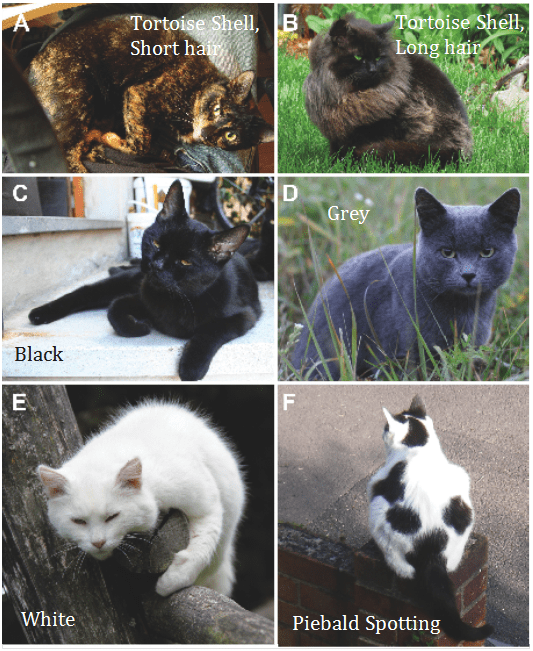
Multiple alleles in fruit flies
In 2000, scientists completed the complex genome mapping of the common fruit fly, Drosophila melanogaster. The fruit fly has been and continues to be a valuable laboratory animal due to its high reproduction rate and the ease with which large numbers of flies can be kept and analyzed. At approximately 165 million base pairs, a fruit fly’s DNA is significantly smaller than that of a human. While humans have 23 chromosomes, fruit flies have only four. Nonetheless, there are approximately 17,000 genes on only four chromosomes. Each gene is responsible for a distinct aspect of the fly and is subject to mutation and the emergence of new alleles.
Normally, the wings of Drosophila melanogaster are quite long. Two mutations occurred at the same locus in different flies’ one of which resulted in vestigial (reduced) wings and the other in antlered (less developed) wings.
When a fly with vestigial wings is crossed with another with antlered wings, the resulting F1 hybrids have intermediate wing lengths, indicating that none of the mutated genes is dominant. Occasionally referred to as the vestigial antlered compound, this hybrid contains two mutated genes at the same locus. Mendelian segregation and recombination are evident.
Apart from the vestigial and antlered wings, there are other phenotypes: nicked wings, strap wings, or no wings at all. The gene variants responsible for these phenotypes are the multiple alleles in this particular fruit fly population.
Multiple alleles among humans
There are traits in humans and other organisms that have three or more different types of alleles (genes). When a trait has three or more distinct alleles, we refer to it as having multiple alleles inheritance. The human ABO blood type alleles/trait is an example of a trait with multiple alleles. Three distinct alleles exist: allele A (IA), allele B (IB), and allele i (IO or i).
If the allele A is present on the chromosome, protein A is produced, and the red blood cells of that individual contain protein A on their membrane. If the chromosome contains the allele B, protein B will be produced, and the red blood cells’ membranes will contain protein B. Finally, if allele i is present on the chromosome, neither protein A nor protein B will be synthesized. These three alleles make up the ABO blood group trait.
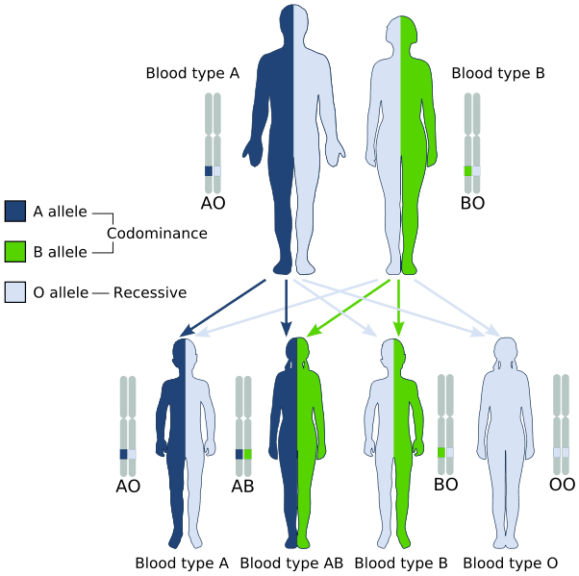
The inheritance pattern of allele A and allele B shows codominance (co-dominance). Co-dominance occurs when neither allele is dominant over the other, and a heterozygous individual expresses both phenotypes. That is, if an individual possesses allele A on one chromosome and allele B on the second homologous chromosome, both proteins are expressed and red blood cells contain both protein A and protein B on their cell membranes.
READ: Non-Mendelian Inheritance – Multiple Alleles (ABO blood type)
The ABO blood type hereditary scheme in human beings is an illustration of multiple alleles blood types. Phenotypes are classified into four categories: blood group A, blood group B, blood group AB, and blood group O. In this case, the population has three alleles. The IA allele when expressed results in the presence of A molecules on red blood cells, the IB allele expression leads to the presence of B molecules on red blood cells, and the IO allele expression results in the absence of such antigens on the red blood cells. The IA and IB alleles are not only codominant but both of them are dominant over the IO allele. IO allele is recessive and thus will be expressed if IA or IB is absent.
Although a population contains three alleles, each individual inherits only two of them from their parents. This results in the genotypes and phenotypes depicted below. Consider that when three alleles are present, there are six distinct genotypes. The number of phenotypes possible is determined by the dominance relationships between the three alleles. Watch the video below to understand multiple alleles in the form of ABO Blood types.
Multiple alleles in plants
While it is widely believed that potato tuber shape is continuous, visual phenotypes such as round or long tubers can be discerned at the diploid level. Although experimental evidence for the presence of multiple allele systems for a potato tuber is being reported for the first time, this study in potato can be compared to one in maize. The recessive allele for tuber shape can be regarded as the qualitatively recognized null or near-null allele. Variation between dominant alleles is quantitative. The view that the (most) recessive allele can be considered a null or near-null allele is consistent with how quantitative effects at a multiallelic locus are described. When additional metric traits are resolved into Mendelian factors using heterozygous parents in experimental designs, conclusions can be drawn about the relative importance of multiple alleles traits to multiple loci in explaining quantitative genetic alleles variation.
Multiple alleles in bacteria
Bacteria possess a large number of genes, several of which have multiple alleles. These various wild-type alleles are frequently associated with distinct types of virulence and can be used to classify subspecies (e.g., housekeeping genes for Multi Locus Sequence Typing, MLST). As a result, it is critical to rapidly identify not only the desired gene but also the relevant allele.
Currently available sequencing-based methods are limited to mapping reads to each known allele reference, which is a lengthy process. Understanding and predicting the pathogenic impact and outbreak potential of a bacterial infection requires more than knowledge of the species responsible for the infection.
Bacterial virulence is frequently regulated on a sub-species level by a collection of specific genes or even alleles, necessitating the use of distinct treatment strategies for infections caused by the same bacterial species.
Antibiotic resistance, for example, is a well-known example of how minor variations in a gene can result in a diverse collection of antibiotic resistance profiles within a single taxonomic group.
Additionally, different alleles of the same gene may be responsible for distinct adhesion and invasion strategies, responses to the infected organism’s immune response, and toxin production.
Apart from its importance for understanding virulence, identifying alleles of specific genes contributes to a more precise classification of bacteria.
Multiple Allelism, Pleiotropy and Epistasis
Multiple allelism may be misconstrued with other common terms in Genetics, such as pleiotropy and epistasis. Let us understand the difference between multiple allelism (defined as the condition of having multiple alleles) and other genetic conditions.
- Pleiotropy refers to the condition wherein more than one gene can have multiple effects on the phenotype. While multiple allelism involves only a single gene with many variants (referred to as multiple alleles), pleiotropy entails more than one gene that determines phenotype. For example, a higher frequency of individuals with albino would have cross-eyes than the pigmented individuals. Thus, apart from having no sufficient pigment production in their skin and hair, another possible feature of albinoes is a cross-eyed trait. However, not all albinoes show this trait indicating that in such cases, the two traits are not linked. (The Complex Expression Patterns of Multiple Alleles – BIOL110F2012 – Confluence, 2012) Another example is eye color. The trait is influenced by more than one gene. Some of these genes are OCA2 and HERC2.
- Epistasis is when one gene has an effect on the expression of another gene. This occurs when genes interact to produce a particular trait. An example would be the determination of coat color in certain animals (e.g. horses) wherein the effect of one gene depends on the influence of another gene controlling the deposition of hair pigment. (The Complex Expression Patterns of Multiple Alleles – BIOL110F2012 – Confluence, 2012)
Try to answer the quiz below to check what you have learned so far about multiple alleles.
References
- Khachatryan, L., Kraakman, M.E.M., Bernards, A.T. et al. BacTag – a pipeline for fast and accurate gene and allele typing in bacterial sequencing data based on database preprocessing. BMC Genomics 20, 338 (2019). https://doi.org/10.1186/s12864-019-5723-0
- Khan Academy, (2016). Multiple alleles, incomplete dominance, and codominance. Retrieved from https://www.khanacademy.org/science/high-school-biology/hs-classical-genetics/hs-non-mendelian-inheritance/a/multiple-alleles-incomplete-dominance-and-codominance on July 18th 2021.
- Nickle, T., & Barrette-Ng, I. (2021, January 4). Example of Multiple Genes Affecting One Character. Retrieved July 20th , 2021, from https://bio.libretexts.org/@go/page/4089
- The Complex Expression Patterns of Multiple Alleles – BIOL110F2012 – Confluence. (2012). Psu.edu. https://wikispaces.psu.edu/display/bio110/The+Complex+Expression+Patterns+of+Multiple+Alleles
- Van Eck, H. J., Jacobs, J. M., Stam, P., Ton, J., Stiekema, W. J., & Jacobsen, E. (1994). Multiple alleles for tuber shape in diploid potato detected by qualitative and quantitative genetic analysis using RFLPs. Genetics, 137(1), 303–309. Retrieved from https://www.ncbi.nlm.nih.gov/pmc/articles/PMC1205946/ on July 19th 2021.




